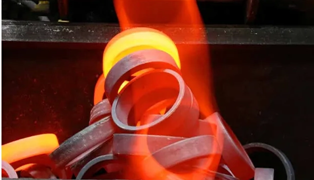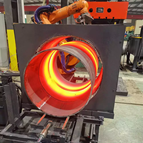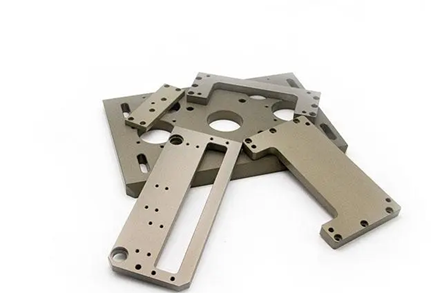Among the various processes of CNC machining, heat treatment is a processing method that is familiar to the public. Do you know what types of heat treatment methods there are
Before knowing the several methods of heat treatment, the editor will first introduce to you what is the general definition of heat treatment Heat treatment refers to a metal thermal processing process that uses heating➡insulation➡cooling and other means when the material is in a solid state in order to obtain the expected structure or performance.
Heat treatment methods can be divided into ordinary heat treatment, surface heat treatment and chemical heat treatment according to differences in heating, cooling methods, structure, performance changes, etc.
Common heat treatment methods include annealing, normalizing, quenching and tempering, etc.
Surface heat treatment methods include induction quenching, flame quenching, point contact quenching, etc.
Chemical heat treatment methods include carburizing, nitriding, carbonitriding, etc.

What are the differences between these heat treatment methods
1. Each has different definitions
Surface heat treatment and ordinary heat treatment are both methods of changing the structure and properties of materials through heating & cooling. However, surface heat treatment only treats the surface of the material and does not change the internal structure and chemical composition of the material. Ordinary heat treatment treats the entire material, including the surface and interior. It is a method that can change the internal structure and chemical composition of the material.
2. Different scope of use
Surface heat treatment only needs to change the surface properties of the material but does not need to change its internal properties, such as surface hardening, surface toughening, etc.; ordinary heat treatment needs to change the internal properties of the entire material. Such as hardness, readability, wear resistance and other internal properties of materials.
3. Different advantages and disadvantages
Surface heat treatment can be performed on specific parts without affecting the basic structure and properties of the material, nor will it cause deformation and embrittlement of the material. Its treatment effect will be limited by the material structure and thickness. Ordinary heat treatment can change the overall properties of the material and the treatment effect is relatively stable, but it is more prone to deformation and embrittlement.
The first half of this article describes the general classification of several mainstream heat treatment methods. Next, the editor will introduce to you the specific treatment methods of the branches of these broad categories.

1. Surface quenching
Surface quenching is a surface heat treatment process that quenches the surface of steel workpieces. The purpose is to improve the hardness, wear resistance and fatigue strength of the workpiece surface. Commonly used in shafts, gears and other parts.
For steel materials, surface quenching refers to using a special heating method to quickly heat the steel surface to Ac3 hypoeutectoid steel (Note It is the critical temperature of austenitization of hypoeutectoid steel. Only when it exceeds this temperature can it be completely Forming austenite) or Ac1 hypereutectoid steel (is the critical temperature of austenitization of eutectoid steel. Only when this temperature is exceeded can austenite be completely formed. This temperature is 727 degrees, and different steels have different value) or above. Subsequent rapid cooling causes martensitic transformation on the surface of the steel to form a hardened layer.
According to different heating methods, surface quenching can be divided into induction heating (high frequency, medium frequency, power frequency) surface quenching, flame heating surface quenching, electrical contact heating surface quenching, electrolyte heating surface quenching, laser heating surface quenching, and electronic surface quenching. . The most commonly used methods in industry are induction heating and flame heating surface quenching.
Among them power frequency surface heat treatment. It refers to industrial frequency alternating current, which is characterized by low frequency and does not require frequency conversion equipment, so the entire equipment is relatively simple. Suitable for high-power smelting equipment, surface induction heating and quenching of large parts, induction threading heating of large and medium-sized parts or blanks;
Medium frequency surface heat treatment. Generally refers to the frequency conversion equipment of 500-10000 Hz, which converts the 50 Hz industrial frequency alternating current into the above frequency range through the frequency conversion equipment. Due to the emergence of thyristor frequency conversion devices, intermediate frequency equipment below 500 or above 10,000 has been put into use. Mainly used for metal smelting below medium capacity, induction heating of forging blanks, surface quenching or diathermic quenching of mechanical parts.
High frequency surface heat treatment. Generally refers to the range of 100-500 kHz. Not long ago, 10 kHz to 100 kHz was still a blank frequency band. The super audio equipment has been successfully developed and has filled this frequency band, mainly to solve the problem of slippery contours of medium-module gears, crank wheels, etc. The research was successful due to the need for quenching. The high frequency band is mainly used for a small amount of experimental research melting and a small amount of precision casting production, and shallow surface boat quenching of 1-2 mm hardened layer.

2. Chemical heat treatment
Chemical heat treatment is a metal heat treatment process that mainly uses chemical reactions and occasionally physical methods to change the chemical composition and organizational structure of the surface of steel parts in order to obtain better technical and economic benefits than homogeneous materials.
Steel parts that have undergone chemical heat treatment can essentially be regarded as a special composite material. The main purpose is to improve the wear resistance, fatigue strength, corrosion resistance and high temperature oxidation resistance of the parts.
Since most failures and damages of mechanical parts occur in the surface layer, especially for parts that work under conditions that may cause wear, fatigue, metal corrosion, oxidation, etc., the performance of the surface layer is particularly important.
Chemical heat treatment mainly includes carburizing, nitriding, boronizing, sulfurizing, aluminizing, chromizing, siliconizing, carbonitriding, oxynitriding, thiocyanate co-seeding and carbon, nitrogen, sulfur, oxygen and boron five elements Co-infiltration, and titanium carbon (nitride) covering.
3. Contact resistance heating and quenching
The principle of contact resistance heating quenching is that after the electrode (roller of highly conductive material) in contact with the workpiece is energized, the low-voltage current passes through the contact resistance between the electrode and the workpiece, causing the surface of the workpiece to quickly heat up the contact resistance and achieve this through its own heat conduction. A process of rapid cooling and quenching. The advantages of this method are simple equipment, convenient operation, easy automation, minimal distortion of the workpiece, no need for tempering, and can significantly improve the wear resistance and scratch resistance of the workpiece, but the hardened layer is thin (0.15-0.35) Microstructure and hardness uniformity are poor. This method is mostly used for surface quenching of machine tool guide rails made of cast iron, and its application range is not wide.
4. Electron beam heat treatment
Electron beam technology has a history of more than 20 years and is widely used in processing industries such as metal welding and cutting. Electron beam heat treatment is a new technology that uses high energy density electron beam heating to perform surface quenching. The electron beam is emitted by the hot cathode (filament) of the electron gun. It is accelerated by the high-voltage annular anode and focused into a beam so that the electron beam hits the metal surface to achieve a heating effect. The heating depth of the parts being processed is a function of the heating acceleration voltage and metal density. When the power is 150kw, the theoretical heating depth in iron is 0.076mm, while in aluminum it is 0.178mm. Electron beam heat treatment has a fast heating speed. , the austenitization time is as short as 0.2 seconds or even shorter, so the surface grains of the workpiece are very fine, the hardness is higher than that of ordinary heat treatment, and it has good mechanical properties.
5. Electrolytic heating and quenching
Electrolytic heating and quenching is a metal heat treatment process that changes the mechanical properties of the surface layer by heating and cooling the surface of steel parts. Surface quenching is the main content of surface heat treatment. Its purpose is to obtain a high hardness surface layer and strong internal stress distribution to improve the wear resistance and fatigue resistance of the workpiece. Electrolyte heating surface quenching is to pass a higher voltage (150-300v) direct current into the electrolyte. Due to ionization, conduction occurs, hydrogen is released at the negative electrode, and oxygen is released at the positive electrode.
The hydrogen gas forms a gas film around the negative electrode and has a large resistance. When the current passes through, a large amount of heat is generated to heat the negative electrode. During quenching, connect the workpiece submerged in the electrolyte to the negative electrode, and the liquid tank to the positive electrode. The submerged part of the workpiece is heated when the power is turned on (the quenching temperature can be reached in 5-10 seconds). After the power is turned off, it is cooled in the electrolyte, or it can be placed in a separate quenching tank for cooling. There are many electrolytes suitable for quenching the surface of Venus, among which W (sodium carbonate) 5%-18% aqueous solution is the most widely used. The use temperature must not exceed 60°C, otherwise it will be unstable and affect the heating effect.
6. Laser heat treatment
Abbreviation LHT. Also called laser quenching or laser phase change hardening, a high-energy laser beam is used to rapidly scan the workpiece, causing the surface temperature of the irradiated metal or alloy to rise above the phase transformation point at an extremely rapid rate. When the laser beam leaves the irradiated part, due to Due to the effect of heat conduction, the cold matrix is rapidly cooled and undergoes self-cooling quenching to obtain a finer hardened layer structure, and the hardness is generally higher than the conventional quenching hardness. The deformation of the workpiece during the treatment is extremely small, and it is suitable for surface strengthening of certain workpieces or local parts of the workpiece that cannot be completed or is difficult to achieve by other quenching technologies. Laser heat treatment has a high degree of automation, and the depth of the hardened layer and the hardened area are well controllable. This technology is mainly used to strengthen the surface of automobile parts or molds to improve their surface hardness, wear resistance, corrosion resistance, strength and high-temperature performance, such as automobile engine cylinder bores, crankshafts, stamping dies, casting mold plates, etc. Laser heat treatment. The laser heat treatment process flow is pretreatment (surface cleaning and pre-applied light-absorbing coating) laser quenching (determination of hardening model and quenching process parameters) - quality inspection (macro and micro inspection).
7. Vacuum heat treatment
Salt bath quenching is limited by the environment and has become a sunset. Vacuum heat treatment is a new heat treatment technology that combines vacuum technology with heat treatment technology. The vacuum environment in which vacuum heat treatment occurs refers to an atmosphere environment below one atmospheric pressure, including low vacuum, medium vacuum, high vacuum and ultra-high vacuum. The actual vacuum heat treatment It also belongs to atmosphere controlled heat treatment.
The application and development of vacuum heat treatment technology has been further improved and promoted. It has the characteristics of no oxidation, no decarburization, clean and bright workpiece surface after quenching, high wear resistance, no pollution, and high degree of automation. Heat treatment technologies such as vacuum annealing, vacuum degassing, vacuum oil quenching, vacuum water quenching, vacuum air quenching, vacuum tempering and vacuum carburizing are widely used in industrial production, becoming one of the most popular and important technologies in heat treatment workshops.
8. Induction heat treatment and ion nitriding heat treatment technology
Induction heat treatment is widely used in the automotive industry, engineering machinery, petrochemical and other industries because of its high efficiency, energy saving, cleanliness, flexibility, etc. Nearly 40% of automotive parts can use induction heat treatment, such as crankshafts, gears, universal joints, and half shafts. wait. Using induction heating, many product processing can be built into fully automatic or semi-automatic production lines, which improves the stability of product quality, reduces labor intensity, and beautifies the working environment. The fastest growing in China is the induction heating power supply. The old-fashioned electronic oscillator tube has completed its historical mission and has been replaced by all-transistors.
Microcomputer-controlled transistors are used to regulate the power supply. The adjustment is stable and convenient, with high precision, and the interference with harmonics of the power grid is greatly reduced. The fastest growing domestically is induction heating power supply. The old-fashioned electronic oscillator tube has completed its historical mission and has been replaced by all-transistors. Microcomputer-controlled transistors are used to regulate the power supply. The adjustment is stable and convenient, with high precision, and the interference with harmonics of the power grid is greatly reduced.
9. Adopt new surface strengthening technology and promote heat treatment in nitrogen-based atmosphere
The original tool surface treatment methods are limited to outdated methods such as steam treatment and oxynitriding, which generally can only increase the supply life by 30-50%. Since the 1980s, my country has independently developed and introduced QPQ salt bath treatment technology and PVD titanium oxide physical coating technology from abroad. The former can stably increase the service life by 2-3 times, has simple equipment and low cost, and is especially suitable for ordinary cutting tools. Nitrogen-based atmosphere is used for protective heat treatment and chemical heat treatment, which can achieve non-oxidation decarburization heat treatment and avoid nitrogen embrittlement in heat treatment. Chemical heat treatment in nitrogen-based atmosphere can reduce defects such as internal oxidation and improve the quality of chemical heat treatment.
Of course, in addition to the above heat treatment methods, there are also modern heat treatment technologies such as controlled atmosphere heat treatment, quenching medium and cooling technology, subzero treatment technology, low pressure nitriding technology, physical evaporation technology, etc. With the development of science and technology, the old Due to low efficiency, environmental pollution and other reasons, heat treatment methods will inevitably be replaced by upgraded new heat treatment technologies. Modern heat treatment has broad prospects for future use.